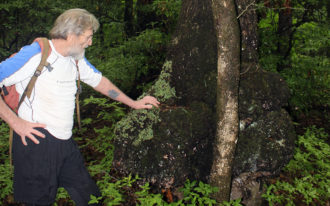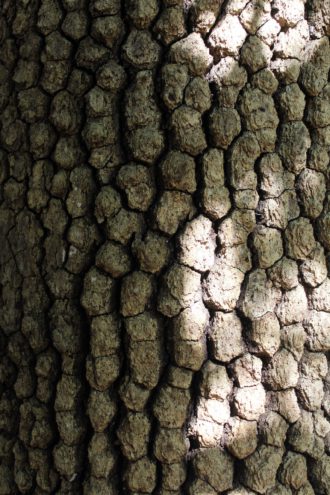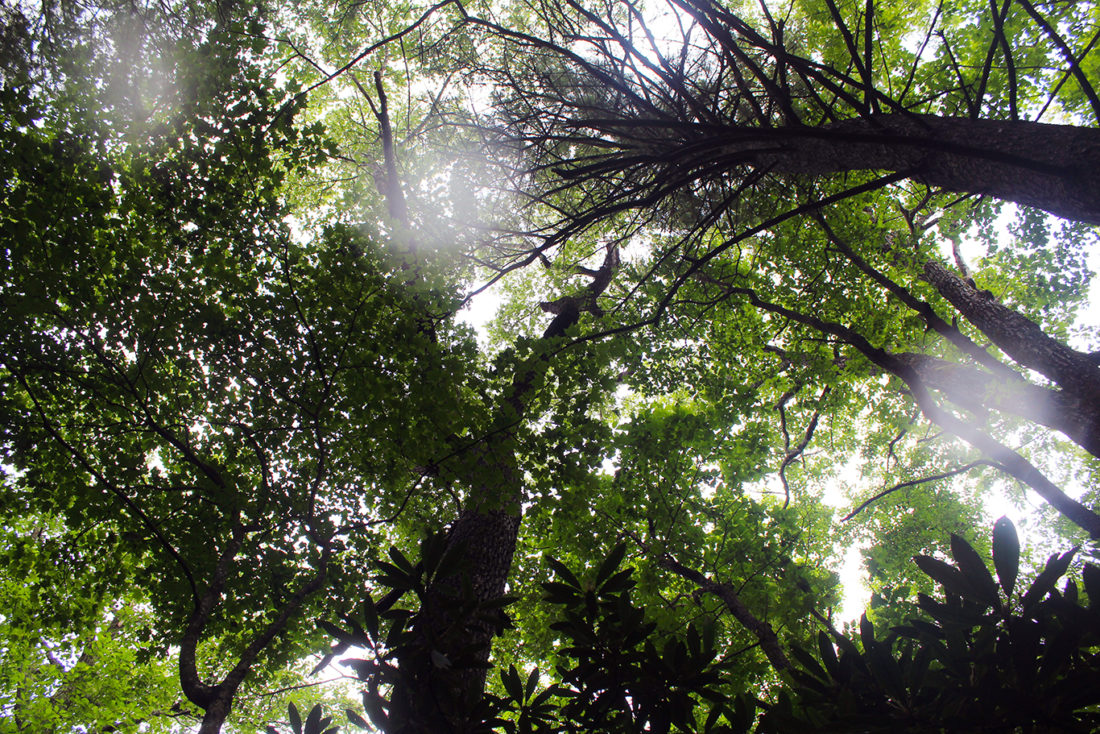By Jack Igelman, originally published by Carolina Public Press. Carolina Public Press is an independent, in-depth and investigative nonprofit news service for North Carolina.
CPP is publishing a four-part series focusing on the Southside Project, a recent initiative by the U.S. Forest Service, to make the national forest more resilient and sustainable. In part two, Jack Igelman reports on the importance of old-growth forests, the new philosophy of forest management and opposition. Part 1 is available here.
Buzz Williams, 72, the founder of the organization Chattooga Conservancy, believes that the scarcity of old-growth forests warrants their protection, even small patches, such as the one on Brushy Mountain.
Among their indispensable functions, scientists say old-growth forests are essential tools in the fight against climate change. Century-old trees store meaningful volumes of carbon and capture carbon from the atmosphere. Harvesting them releases greenhouse gasses, worsening the impact of climate change.
“We urge Congress to move in the opposite direction by shifting from more logging toward natural climate solutions that store carbon in mature and older forests and allow naturally regenerating forests to continue growing for greater carbon accumulation,” said hundreds of scientists in a November 2021 letter to President Joe Biden.
The letter called for public land managers to support a new mission to protect and restore old-growth networks to help mitigate the effects of climate change and to help native species migrate and adapt as habitats shift.
On April 22, Biden signed an executive order aimed at protecting old-growth forests. The order directs the U.S. Forest Service to inventory the old-growth forests on federal lands over the next year and identify the threats to better safeguard them.
Forest Service spokesperson Cathy Dowd said the agency is working with the Department of Interior to analyze the public comments received, jointly define, identify and complete an inventory by April of old-growth and mature forests on lands managed by the Forest Service and the Bureau of Land Management.
As the impact of climate change accelerates, the battle for sections of small patches of forest like this one on Brushy Mountain will likely intensify. The Forest Service’s approach to Brushy Mountain underscores the challenges of the upcoming forest plan regarding what timber to cut and which stands to leave.
In 2013, the U.S Forest Service launched the assessment phase of its land management plan revision process for Western North Carolina’s Pisgah and Nantahala national forests. Over the course of the decade, the Forest Service received thousands of public comments weighing in on issues ranging from trail building to timber harvesting.
Earlier this year, the agency finally revealed its strategy that will dictate the overall management framework of the forests, including the strategy to address the forests’ health and resiliency.
The priorities and values of forest users and advocates vary widely in Western North Carolina because of deeply held historical, cultural and philosophical views. Finding middle ground around the range of values has been among the greatest challenges of the forest plan. The forest plan will be finalized at the end of this year or in early 2023. Carolina Public Press will continue to report on this in the coming year.
A new philosophy of forest management and climate change
The decision to harvest trees on Brushy has not only attracted local activists, but the project is also garnering national attention. In a November report, the Climate Forests campaign, a coalition of dozens of environmental organizations, highlighted 12 government-run projects targeting old-growth forests across the nation, including the Southside Project.

“[Prioritizing the protection of old-growth stands] isn’t a radical view; it’s the best science available,” said Williams. “Yet public land managers aren’t taking steps necessary to implement the changes in management as recommended by the scientific community.”
Similar battles have been fought in the past with the Forest Service as it embraces a new philosophy of forest management.
The revision of the plan is managed by the National Forests in North Carolina office, which is based in Asheville and supervises the state’s four national forests. The 1976 National Forest Management Act, or NFMA, requires forests to have a plan describing the strategic direction for management of forest resources.
The legislation was designed to counter growing concerns about damage to natural ecosystems on public lands. The NFMA is considered a cornerstone of environmental law to protect biodiversity in national forests and to ensure public involvement. Its passage placed meaningful restrictions on timber harvesting, such as clear-cutting and placed forest management decisions under much greater scrutiny from the public.
In 1984, the first proposed land management plan for Pisgah and Nantahala national forests called for 389,000 acres of Western North Carolina’s national forestlands to be harvested by clear-cutting over five decades. The plan was deeply unpopular, particularly among environmentalists who saw the scale of clear-cutting as neither reasonable nor sustainable. It would be the equivalent of 221,000 soccer fields, or nearly the area of Buncombe County.
Fueled by widespread opposition, a grassroots effort led by the Western North Carolina Alliance, now MountainTrue, to an appeal of the plan and a major overhaul. The resulting plan, which was revised in 1994, was then considered one of the most environmentally sensitive management plans in the nation.
The current plan revision process will replace the 1994 plan and is also guided by a 2012 Forest Service planning rule that mandates more significant participation and feedback from the public.
In 2019, when CPP began reporting on the Southside Project, Williams was concerned about another unit in the Southside Project, a 23-acre site on Round Mountain scattered with aging white and chestnut oaks near the South Carolina-North Carolina state line. Round Mountain also includes small patches of old-growth forests.
The project was announced in 2017 following the release of an environmental impact statement and public comment period. Michael Wilkins, then the Nantahala National Forest district ranger, announced the final Southside Project decision in February 2019.
Williams’ organization, the Chattooga Conservancy, opposed the decision because of the impact on the old-growth forest ecosystem, water quality and biodiversity.
“Only one-half of 1% of the forest is old-growth in the Southeast,” Williams told CPP in 2019. “That is the reason within itself to leave it alone. Cutting old-growth right now under any circumstances is foolish and irresponsible.”
While the Chattooga Conservancy is not opposed to timber harvesting in the forest, this isn’t the spot to do it, said Executive Director Nicole Hayler.
“We are not a zero-cut organization,” she said. “I think we are reasonable. You have this really rare resource with all of these conservation values. We don’t need to liquidate it.”
In 2018, the Southern Environmental Law Center filed an administrative objection to the Southside Project decision. Among its objections was that the Forest Service’s environmental analysis failed to adequately analyze the impacts of logging existing old-growth. In addition, the objection argues that the analysis of green salamanders ignores best available science.
The Forest Service responded to the objection in February 2019 with slight modifications to the final decision, for example, adding a 100-meter buffer around known green salamander habitat.

In its response to the SELC’s objection, the Forest Service wrote that while it “should provide and restore old-growth on the landscape,” this spot and others within the project are either not old-growth or unique enough to protect. The Forest Service, in its project decision and environmental assessment, said the 26-acre stand on Brushy Mountain meets the minimal operational definition for old-growth defined by the Region 8 Old Growth Guide.
In an internal Forest Service email obtained by the Chattooga Conservancy, forester Brandon Stephens went a step further and, based on a field visit, said that the trees on Brushy likely fall short of the operational definition of old-growth.
“I actually don’t agree with the environmental assessment that in 2019 (or 2021) this stand meets operational old growth,” he wrote. “This stand is certainly on the cusp of operational old growth … but I think the strong opinions on this being ecologically old-growth from the stakeholders [commenters] is disproportionate to the actual stand data. There’s more afoot in the public opinion here for this stand than ‘old-growth’ in my opinion.”
According to the agency, even if the stand on Brushy is considered old-growth, Brushy Mountain and other stands like it throughout the forest and within the 18,944-acre project analysis are not uncommon; 33% of land in the analysis area have forest stands 100 years or older. In addition, they said, the stands in question have been sufficiently impacted and were “selectively harvested at some time in the past.”
Although the timber sale is complete, it’s possible to use the courts to stop the Southside Project. For example, earlier this year, several municipal governments and environmental groups sued the Forest Service to stop a timber-thinning project in the Los Padres National Forest in California. And in June, Kentucky Heartwood filed suit against the agency over a timber project in the Daniel Boone National Forest.
Behind the scenes
The Southern Environmental Law Center obtained meeting minutes and other documents that shed light on how the Forest Service came to their forestwide management scheme regarding old-growth and how they plan to manage future projects that involve timber prescriptions, including harvesting. These documents were obtained through a Freedom of Information Act request and shared with CPP.
The documents are evidence of the effort the Forest Service has dedicated to managing old-growth within the forest and their methods “to create the best defensible old-growth layer based on the best available information.”
However, Susannah Knox, an SELC attorney, said the internal documents “show clearly that the agency wants to be able to do more timber sales just like this one without having to consider old-growth.”
In July 2020, according to internal minutes from a meeting regarding old-growth management, former National Forests of North Carolina supervisor Allen Nicholas said, “We’re trying to find a way to get this issue out of the limelight every time we propose a project. [I] would like to see the right designated network to minimize the issue during project development.”
Dowd said that the documents included in the FOIA request “reflect thinking and discussion around old-growth as we developed the new forest plan.”
The documents provide insight as to how the Forest Service developed a larger old-growth network in the proposed forest plan. “Prior to setting the network at the plan level, efforts were made to create the best defensible old-growth layer based on the best available information,” said one of the documents regarding old-growth in the plan. New patches of old-growth were added on the basis of ecozone representation, distribution in the forest and competing management needs.
The current 1994 plan includes 213,215 acres in the old-growth network.
The internal discussions indicate that the Forest Service anticipates conflict with opponents of harvesting small patches of old-growth.
In a summary of the “pros and cons,” the Forest Service said its approach to managing old-growth was “unlikely to reduce the passion around small patches of old-growth at the project level.”
Small patches of old-growth stands have not been accurately tracked over the last two to three decades. While most large and medium-size patches are known, relatively small sections that are less than 100 acres and unknown or unrecorded may cause conflict when developing future timber projects.
In the July 2020 meeting, Forest Service employee Jessie Howard said that documents for every project survey for old-growth are requested through the Freedom of Information Act and “challenged on every single project.” Both the Chattooga Conservancy and the SELC made FOIA requests regarding the Southside Project.
New decision makers
Allen Nicholas, the former supervisor, retired in 2020, so he is no longer the decision maker. The current supervisor is James Melonas. Melonas’ arrival at the state headquarters in Asheville is at a pivotal moment for North Carolina’s two largest national forests: Pisgah and Nantahala. Within weeks, Melonas will finalize the land management plan.
In an interview with CPP in 2021, Melonas said he will prioritize relationships with forest stakeholders and encourage more engagement with communities left out of the development of forest projects, such as Black Americans who live near public lands throughout the state.
Within the documents obtained by the SELC through a FOIA request, the agency acknowledged that the old-growth issue is as complex as any in forest management.
“A primary goal I was to see accomplished is to remove the debate over old growth at the project level,” said Nicholas. “As we finalize the plan, we will alter our current designated old-growth network by setting aside a larger base size and a process for adding individual patches or groups of patches…”
Although old-growth is currently underrepresented in Pisgah and Nantahala, Forest Service “natural range variation” models suggest old-growth should be roughly 50% of the forest, and the Forest Service expects that over time, forests currently not considered old-growth, will age into that category.
However, as a result of the current deficit of old-growth throughout both forests, notes from Forest Service meetings point out that “projects are routinely challenged” that have old tree stands, whether they are actually considered old-growth or not.
During development of the chosen plan alternative regarding old-growth for the proposed forest plan, the agency considered three management alternatives to address the amount of old-growth in the forest, known as the old-growth network. The old-growth network is a footprint of aging tree acreage scattered throughout the forest. The network includes forest that is current old-growth as well as forest that is expected to age into old-growth forest in coming decades.
The three alternatives considered by the Forest Service to manage the size of the network included:
- Limiting project level adjustments to specific kinds of patches.
- A “cap and trade network” proposed by the Nantahala-Pisgah Forest Partnership that would allow the addition of undiscovered patches of old-growth in exchange for lower quality forest within the old-growth network.
- Setting the old-growth network at a fixed size over the life of the plan without adjustments
The Forest Service chose to set aside a larger base of old-growth without adjustments to its size.
In the proposed forest plan, the Forest Service will expand the old-growth network from its current size, 213,000 acres, to 266,000 acres, or roughly 25% of the forest’s land base.
Dowd told CPP that the 54,000-acre increase in the old-growth network is larger than any other alternative presented in the draft forest plan alternatives.
“We’re increasing the size of the designated old-growth network by more than 54,000 acres, up to about 265,000 acres, which is more than 25% of the forest and much larger than any other alternative,” Dowd said.
According to the FOIA documents, the Forest Service said the approach provides certainty in the scale of the old-growth network, reduces the analysis burden at the project level and improves the potential for a functional network of old-growth.
However, the chosen alternative of a fixed old-growth network size does not permit additions of newly found old-growth at the project level.
That’s a problem, said Knox with the Southern Environmental Law Center.
“What we learned from the [internal FS] documents is that in the planning process, the Forest Service has essentially decided that existing old-growth doesn’t matter if it’s not in the designated old-growth network,” said Knox. “Their approach to the old-growth network in these forests doesn’t follow the guidance [from the Biden administration], and really flies in the face of the obligation to protect and restore existing old-growth.”
One consequence of harvesting small patches of old-growth forests, such as the one on Brushy Mountain, is the impact on species that depend on them.
Including the rare green salamander.
The salamanders are recognized by the state as a “threatened species” and a “species of greatest conservation need.” According to experts, they are increasingly rare and dependent on the patch of old-growth on Brushy Mountain.
Yet, little is known about the elusive salamander, and scientists warn that altering known green salamander habitat on Brushy Mountain in the face of human-driven climate change is unwise.






The cutting of our mature hardwood forests -particularly as our increasingly and undeniably planetary “situation” worsens- is an absolute travesty. And the argument that the cutting of these mature forests produces “healthier” forests is complete and total nonsense. What it does produce is immediately degraded water quality within the watershed… along with more flooding, vanquished -basically forever- biodiversity found within these mature hardwood stands, and severely degraded wildlife habitat. What it also does though is keep the local dinosaur timber extraction businesses.. the sawmills, chip mills, and the newly spawned wood pellet “biomass” mills …humming. Period, end of story. And the notion that the US Forest Service’s timber harvesting “scientific quotas” are about science is nothing short of ludicrous… as is their claim that the “selective” cutting within these mature stands of hardwoods actually improves the stand. The Forest Service’s timber extraction quotas are a purely political calculus driven by their completely outdated “mission mandate” under the auspices of the US Dept of Agriculture.. of which they are very much part and parcel of. The US Forest Service’s latest “forest plan” for the Pisgah and Nantahala National Forests amounts to a doubling of the timber harvesting from the previous plan… so the mature hardwood forests found throughout the Pisgah and Nantahala Forests are now clearly on the chopping block. The 55k that the Parton Lumber Company of Rutherfordton is paying for this magnificent stand of irreplaceable old growth forest up there on Brushy Mountain won’t even cover the cost of the roads that the Forest Service will be required to put in, in order to reach this remote stand of untouched forest. The institutionalized systemic corruption found throughout the US Dept of Agriculture/ the US Forest Service is clearly on display here for all to see. This can’t continue ..this shortsightedness ..to put it kindly. We can do better… we must do better. What happens to our forests is ultimately what happens to us.